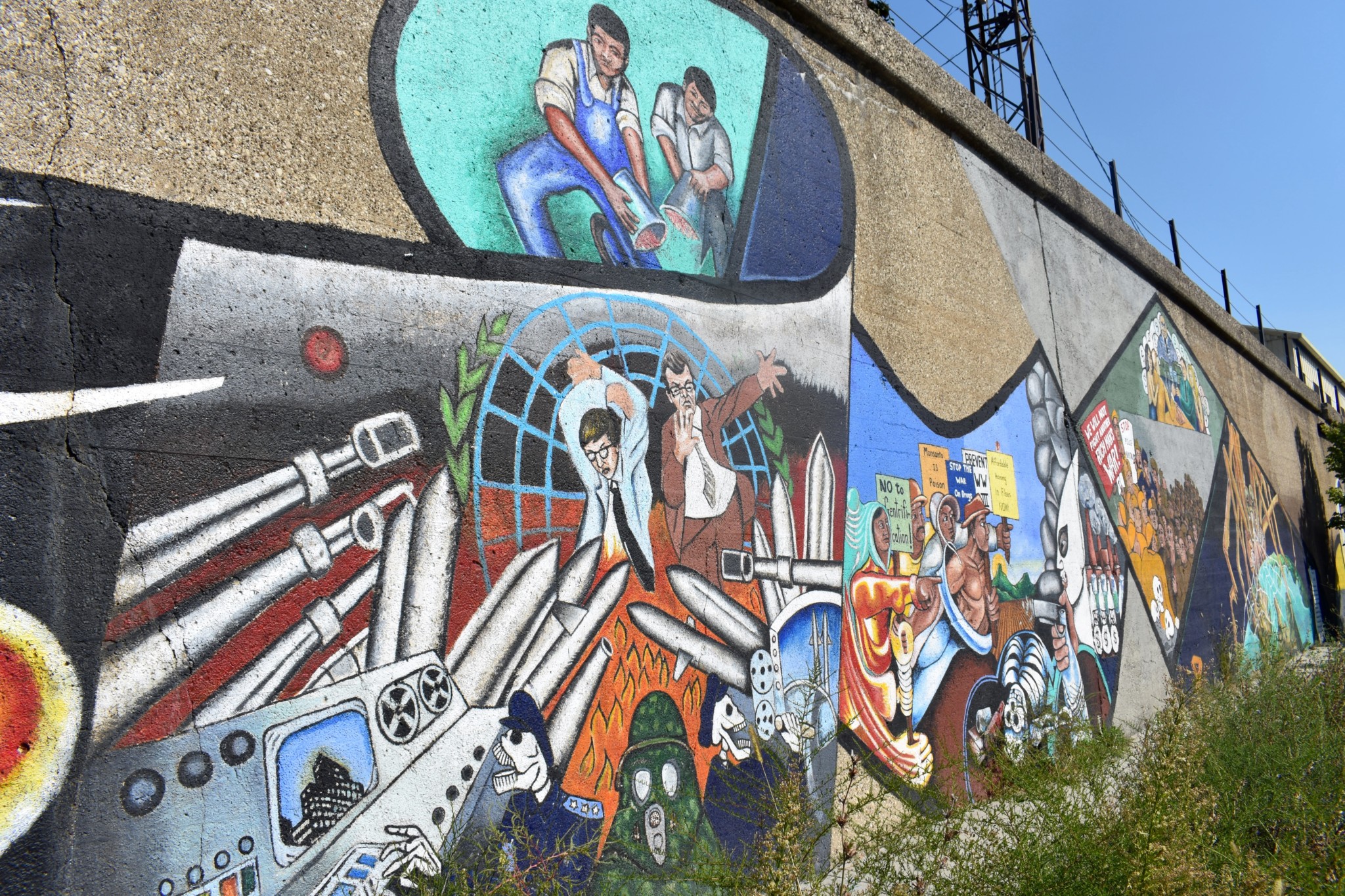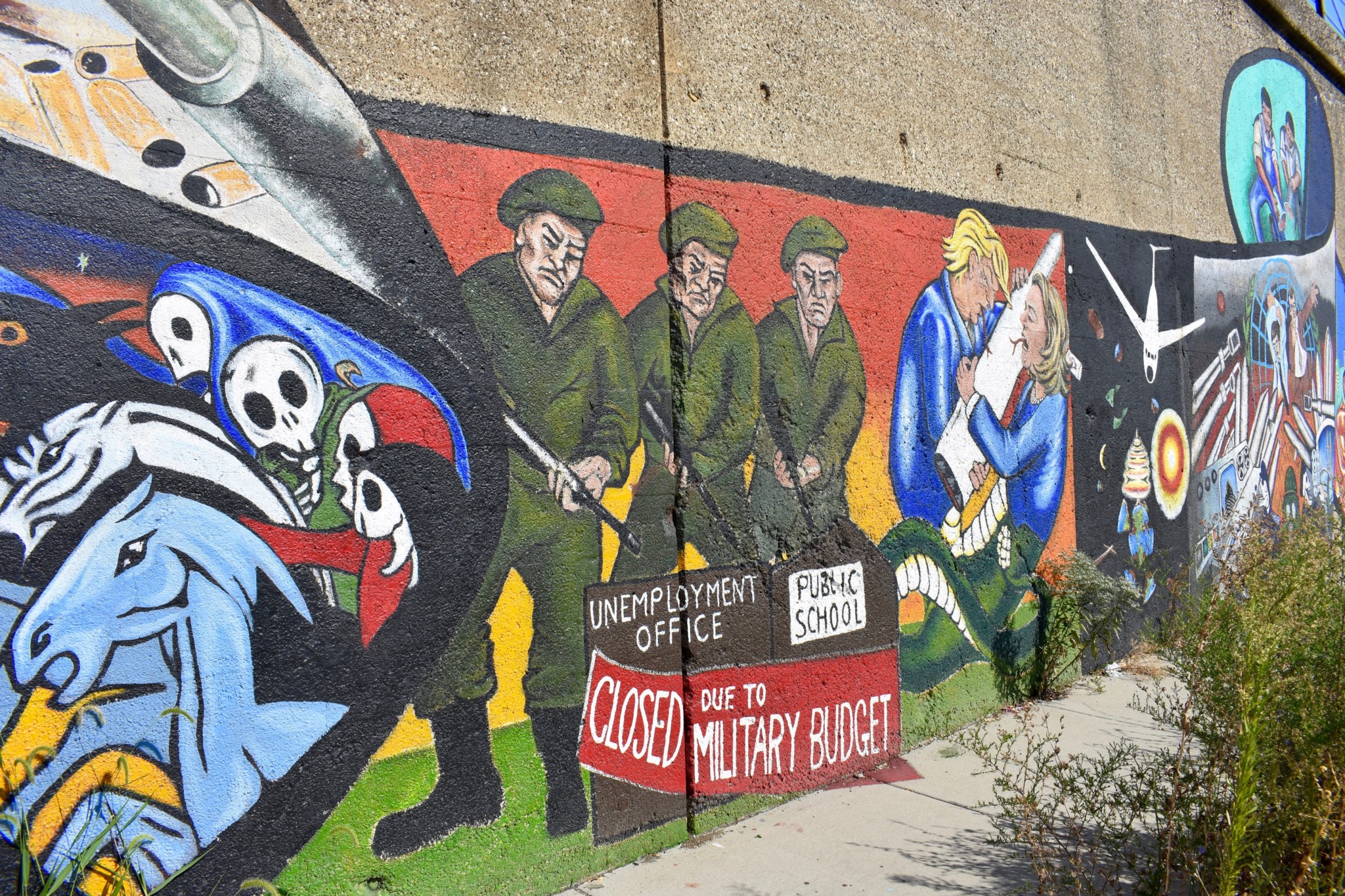- Best Performance Space
- Best Place to Take Grandma Sally
- Best Mural to Get Inspiration For a Revolution
- Best Pork
- Best Family Art Space For Your Kid To Pick Up the Jarana
I came to Chicago in 1986 with a friend who wanted to live here and who convinced me to stay as well. During my first few years, I worked in many different places and lived in various Mexican neighborhoods around the Chicago area. I settled in Pilsen about fifteen years ago, where I began teaching art classes and workshops at bilingual schools.
It’s convenient that, since I’m an artist and musician, I don’t need English in order to develop myself professionally. It helps that I live in Pilsen, where I have found my people to share our culture with. It is an important artistic and cultural center for Mexican and Latin American peoples in the Chicago area. Although other neighborhoods have Mexican communities as well, none are as central and busy as Pilsen.
Pilsen is very much like my hometown of Mexico City, because people from all over Mexico come together to share their differences. Mexican cuisine, for instance, varies enormously from state to state in Mexico, but you’d be hard pressed to find a Mexican platter that isn’t available in Pilsen. We have the best carnitas, tacos, tortas, sopes, tostadas, and even chapulines [grilled crickets from Oaxaca] in Chicago. We also have the best ice creams, and the best tortillas.
Pilsen also has the National Museum of Mexican Art, and many cafes and art galleries have opened that share and promote our culture. There is also a wide variety of Mexican music that can be found all over Pilsen: Aztec danzantes concheros, jarana players from Veracruz, mariachis, northern bands—you name it. A lot of people from other Latin American countries find their way to Pilsen because of the art, music, and activism.
As a Latin American revolutionary musician myself, I have played songs committed to Latin America and oppressed peoples in many different settings. For nine years, I played at a very popular restaurant called Decima Musa, where artists and musicians got together and discussed problems in Pilsen, Chicago, the United States, and Latin America. We’ve organized fundraisers for sick community members and for struggling Latin American countries, as well as political events for Mexico and the United States. Since one earns much more money working in the United States than they would in Latin America, it is important that we share our successes with the people who can’t be here.
One can see the country’s economic power and technological advancements improving every day, and this doesn’t always have good consequences for the people in Pilsen. As the United States and Chicago grow economically, immigrants and poor people can have trouble keeping up, and end up getting displaced by those with more resources. Today, more community members live in areas further from the center of the city than fifteen years ago because housing prices (and their family sizes) have increased. Luckily, some people’s houses and community centers are still available for use, and there’s enough parking for people to drive in and take advantage of Pilsen’s resources and businesses.
In these respects, Chicago is not so different from Mexico City. But it also has many important differences. Although people call the United States the Land of Liberty, one could argue that the United States—with all of its rules and regulations, its hefty fines and harsh punishments—is less free than Mexico. Here, one must get permission to protest, to go camping, to grill food in a park, to remodel one’s house, and even to park one’s car on the street. It feels odd to say it, but I sometimes miss Mexico’s freedom. In Mexico, it’s different. People speed through stop signs, park on the wrong side of the roads, build their houses uniquely, and camp or swim anywhere they want. But it’s a little like that in Pilsen, as well—people disregarding the law in familiar and harmless ways like these all the time. Cars will be parked on the wrong side of the road; apartments might be divided up illegally; and sometimes, in the summer, residents will flood a street with water to play and wash their cars in. We’re very lucky. Living in Pilsen means having the benefits of living in the Chicago, but with some of the best parts of Mexico as well. (Translated and edited by Haydée Marino)
Ramón Marino is an artist and musician from Mexico City who’s been living in Pilsen, and teaching art at Northeastern Illinois University, for fifteen years.
La Citlalin
Citlalin means star in Nahuatl, a language in the Uto-Aztecan family of languages. La Citlalin, a community art gallery and performance space on Blue Island Avenue, is aptly named then: its founder, Gustavo Sanchez, told me that he “called the venue Citlalin for illumination—the stars are the people that come and perform… and not just the artists, but the people they illuminate.” Indeed, Citlalin is home to a stellar cast of artists and musicians from all over the city, the country, and the world. They bring with them a whole constellation of arts: music, dance, poetry, comedy, and theater in the performance space, and art exhibitions in the gallery.
Much of the programming showcases artists and musicians operating in various Latin or Native American traditions, opportunities for whom have diminished as other Latinx galleries and venues are edged out of Pilsen by gentrification. Sánchez is working to keep it alive and well in La Citlalin: a cumbia band rehearses in the background when I stopped by; before them, an actress rehearsed a monologue in Spanish that she’d perform for an audience later in the week. He speaks with pride about what he’s accomplished: “I grew up here, and since I was a kid, most of my friends—I would say my secondary family—are artists… I’m very lucky to do what I love to do, to be surrounded by all this.”
Sánchez wants the space to be inviting to other artists as well. “It’s accessible,” he says, beaming. “If you’re going to bring quality, if you’re going to grow up as a musician, or as an artist… the space is yours.” Noche de Guitarras, for example, is held on the second and fourth Friday of every month as an upbeat opportunity for any kind of string instrument player to jam out with some other musicians before a crowd. It’s free for all. Sánchez’s passion, not profit, is what has brought Noche de Guitarras to be—and really, everything else that La Citlalin does and is. “This venue, it’s my little sandbox, where you can come in and make your own castle, and have a good time. That’s the whole idea about it.” (Rami Kablawi)
La Citlalin, 2005 S. Blue Island Ave. Noche de Guitarras performances second and fourth Friday of the month, 9pm. (312) 480-1096. citlalingallerytheater.com
Best Place to Take Grandma Sally
Textile Discount Outlet

When my eighty-five-year-old Jewish grandmother—who grew up at her father’s fabric store in New York City’s garment district—first entered the Textile Discount Outlet, she gasped, “I am ten years old,” and started to cry. The three-story fabric warehouse is filled floor-to-ceiling and wall-to-wall with reams of fabric to meet all of your textile needs. That’s 75,000 square feet of fabric, notions, and more. In the basement, you are sure to find every button you have ever lost, and the backroom definitely has a fabric to match your parents’ couch. Boas hang from the ceiling and exact replicas of red carpet looks line the entryway, keeping watch over the cutting table where sales manager Gerri Kay rattles off the price of every fabric, trim, buckle, or lace her staff hold up. “Gerri! Price?” Cottons and African prints range from two to four dollars per yard and velvets are closer to seven dollars, which any seasoned crafter knows is amazing. Fancier fabrics like satins, sequined fabrics, and upholstery get closer to ten or twenty dollars per yard. (The “Beyoncé Lace”—at $30 a yard—is an exception.) After being in the silk trade for nearly two decades, Gerri was poached by owner Saul Lieberman to run this warehouse, which she says is in fact intended to replicate the 1940s New York City fabric stores of my grandma’s (and my inherited) nostalgia. But we aren’t the only ones drawn to the place. On any given day, the Textile Discount Outlet is filled with skilled quilters filling carts with colorful cottons, SAIC students stocking up on reams of neon spandex, and whole families weighing in on quinceañera dress fabrics. When I needed 180 yards of rip-stop nylon (don’t ask), four staff members shared the work of identifying the fabric, carting it on the freight elevator, measuring, cutting, and generally helping me out. The Textile Discount Outlet evokes an era when, if you needed something, you made it, and when you loved someone, you made something for them. And with cotton going for three dollars a yard, Textile Discount reminds us that it wouldn’t be so hard to bring that era back. (Bess Cohen)
Textile Discount Outlet, 2121 W. 21st St. Monday and Thursday, 9:30am–7pm; Tuesday and Wednesday, 9:30am–5pm; Friday, 9:30am–2pm; Sunday, 10am–4pm. (773) 847-0572. textilediscountoutlet.com
Best Mural to Get Inspiration for a Revolution
Prevent World War III Mural

Those who’ve visited “Prevent World War III” since 2016 might have noticed paintings of Donald Trump and Hillary Clinton wrestling over a missile. But these images belie the mural’s true age. Its story really begins in a presidential election decades before last November.
In 1980, Ronald Reagan’s nomination as the Republican candidate galvanized a local artist network. John Pitman Weber, an artist and activist, put out a call to create a mural on an embankment of the Burlington Northern Railroad (now BNSF Railway). Ten prominent Midwestern muralists responded, completing the project over the course of that summer. They designed it to be like a strip of film, satirizing Reagan’s background in Hollywood, while also allowing for the montage-like stream of political messages. The first panel, for example, is of a group of Colombian revolutionaries bearing a picture of Che Guevara and calling for the end of American imperialism; the last depicts the earth in the clutches of a capitalist system reimagined as a gargantuan and rather terrifying spider-monster. The panels between are peopled with images of military, mechanization, and resistance by indigenous peoples and people of color. The content of “Prevent World War III” retains much of its resonance today. One can only hope that its title doesn’t as well.
As if to accentuate timeliness, much of the mural looks new. It kind of is. Armed with a $10,000 grant, Marcos Raya—one of the mural’s original artists—spearheaded a restoration effort in 2016, not the mural’s first alteration or touch up since 1980. So even if you’ve seen “Prevent World War III” before, it’s about time to take another trip. It’s a good reminder of what’s worth fighting for. (Michael Wasney)
Prevent World War III, S. Western Ave. and W. 18th Street.
Carnita Uruapan
Immediately upon entering this Pilsen staple, you know you are about to experience something magical. On the left is a butcher-like counter with heaps of delicious looking meat, chicharrones, guacamole, and more. You are likely greeted with several happy smiles, a packed room, and a chunk of carnitas to sample. Opened in 1975 by “El Guero” Carbajal, Carnitas Uruapan brings the unique flavors of Carbajal’s hometown, the Mexican city of Uruapan, to Chicago.
Carnitas, a slow-roasted pork that is characteristically crisp on the outside and extremely tender on the inside, can come from a number of different locations on the pig. At Uruapan, you will find a selection including lomo, costillas, and Chamorrito, just to name a few. All cuts are offered by the pound or the taco, and can be accompanied with a side (or pound) of chicharrones (fried pork skins) and ensalade nopales (cactus salad). The pork skins offer a bit of crunch to the soft and juicy pork, and the salad adds a nice bit of tanginess to the rich flavors. And make sure to grab a side of frijoles and guacamole to finish off the meal. If you cannot decide or you are short on cash, make sure to order the special—a selection of carnitas, refried beans, salad, and chicharrones for under ten dollars.
Although this spot is only open for lunch and early supper, it is conveniently located directly across the street from the 18th Street Pink Line and with its quick service, it is a must-visit for a flavorful and satisfying lunch break or pit stop on the way home. (Bridget Newsham)
Carnitas Uruapan, 1725 W. 18th St. Monday–Friday, 9am–5pm; Saturday–Sunday, 7am–6pm. (312) 226-2654. carnitasuruapanchi.com
Best Family Art Space For Your Kid To Pick Up the Jarana
Son Chiquitos
Son Chiquitos has been teaching kids and their families about Mexican art, music and dance, and the Spanish language going on eight years now. But this isn’t your run-of-the-mill Spanish-language programming for children—and the children agree. “It’s not really like other camps,” ten-year-old Isabella Ortiz tells me. “[It] teaches you a lot about the actual world.”
Rosa Ortiz—cofounder of the organization, and Isabella’s mother—puts it another way: “We’re really helping them become more global citizens,” she says of children like her daughter. Rosa started her work because she “saw a need for children to engage in a fun and exciting way to learn the Spanish language.” Fun and exciting were where she sought to differentiate Son Chiquitos from other language learning programs. “The last thing we wanted our kids to be in was a class, sitting down in front of a teacher, and have them write: ‘Yo hablo Español.’” Instead, Son Chiquitos turns to art, music, and dance—particularly to those relating to sones, musical traditions rooted in the south-central part of Mexico—as a way to teach both proficiency in Spanish and a love of heritage. Son Chiquitos also teaches social justice. Its annual summer camp, Son y Arte, embraces a new theme every summer. This year’s theme was El Agua es Vida—water is life.
Best of all, Son Chiquitos isn’t just for kids. I spoke with Rosa and Isabella on their way home from the family workshop, which they both participated in. On the first and third Saturday of the months between September and May, the free family workshop brings together the young, the old, and everyone in between for an hour-and-a-half-long session of making art, playing music, and having a ball. Older kids like Isabella get to learn the Jarana, a string instrument prevalent in sones. Still, there’s a little something for everyone, younger siblings and parents included: “A two-month-old can be engaged in music. A two-month[-old] can be engaged and seeing their parents, their family members dancing,” Rosa says. “It really nurtures the ties of family, language, and culture through the arts. That is really invaluable for the families that have been part of this program.” (Michael Wasney)
Son Chiquitos workshops: Heritage Middle School, 6850 31st St., Berwyn, IL. Son y Arte Camp: Rudy Lozano Leadership Academy, 2570 S. Blue Island Ave. First and third Saturday of the month, September–May, 10am–11:30am. Free, $5 suggested donation per family. All ages. sonchiquitos@gmail.com. sonchic.com
Support community journalism by donating to South Side Weekly


As a non Pilsen resident I am applauding this column wherein its colors, flavors, visions, sounds and heartbeat are so well depicted.